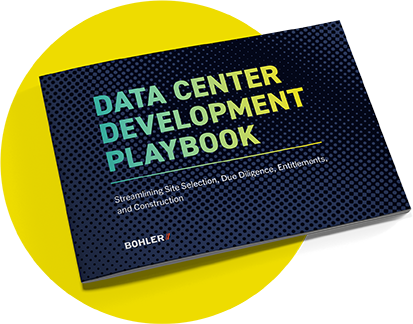Stay in the Know
Get our insights and latest news straight to your inbox.
According to an August 2022 article by Globe Newswire, approximately 2,825 megawatts of power capacity will be added to the data center market in the next five years. The same report forecasts the U.S. data center construction market to reach $25 billion by 2027.
While the need for data centers continues to increase, finding a suitable property with the right zoning, utilities, and development timeline can be challenging. The following three site selection considerations can help an owner or developer determine whether a site is a prime data center opportunity.

Power, fiber, and water are essential to data center operations and may limit speed-to-market if they are not readily available. When assessing utility availability for a potential site, consider the following:
Data centers need power, and they need it fast. Generally, a large site requires upgrades to the existing power grid and its own substation to supply current. If an end user can control the variable of power by adding a substation, it can help them get to market more quickly.
Fiber optic infrastructure continues to improve and is generally located in many places that are already heavily developed. If fiber is not available at a potential site, however, it could be a simple and cost-effective process to bring fiber where it is needed, so long as there is available space in the public right-of-way to install the new fiber. (Often, a shorter path for the new fiber passes through privately-owned parcels. To use this path, easements must be obtained from the owners, which be a time-consuming process.
In addition to power and fiber, data centers draw a significant volume of water, used to cool the server racks and equipment. As municipality interest in green initiatives rises, using reclaimed water is a great option that can save up to millions of dollars over potable or domestic water.
Many local land development codes lack clarity regarding data centers, which can slow a project’s progress. Many ordinances do not specifically address data centers, and the assets sometimes fall under the less desirable “industrial” category. However, even if a potential property sits in an ambiguous zone, there could be a simple fix.
The property could be rezoned – in as little as three months in some locations – to a zone that allows data centers. With this approach, developers don’t necessarily have to state publicly their intention to build a data center, often making it easier to obtain approval.
Another option is to apply for a special exception to allow data centers. However, applying for a special exception makes it clear that the property will be a data center. Depending on the jurisdiction, developers may be required to send notifications to adjacent property owners, which could result in objections.
The key is to work with a site civil engineering consultant and land use attorney who can help determine zoning needs and keep the project moving to hit the end delivery date.
See Related: Addressing Community Concerns in Data Center Development
Data center tenants generally need to build two buildings on a site to take advantage of efficiencies in utilities and security. This means a feasible site size is approximately 40 acres at a minimum, though some developers and tenants could be interested in much more. Without needing to access major roadways, data center developers may consider non-traditional locations, but data centers must be designed to cope with the unexpected. They generally are more likely to be impacted by natural effects like flooding.
When it comes to geographical location, Northern Virginia still dominates the market. Submarine fiber cables in Virginia Beach are making the Interstate 95 corridor attractive for data centers. However, the high cost of land in Virginia is leading developers to markets like Atlanta, Ohio, Texas, and parts of New Jersey.
See Related: Succeeding with Imperfect Sites
Through each of these factors, there are several things that are available to developers to help move data center projects forward. Taking advantage of these benefits could save developers time and money.
Read more in Data Center Development Download: What Makes a Great Site?
Get our insights and latest news straight to your inbox.